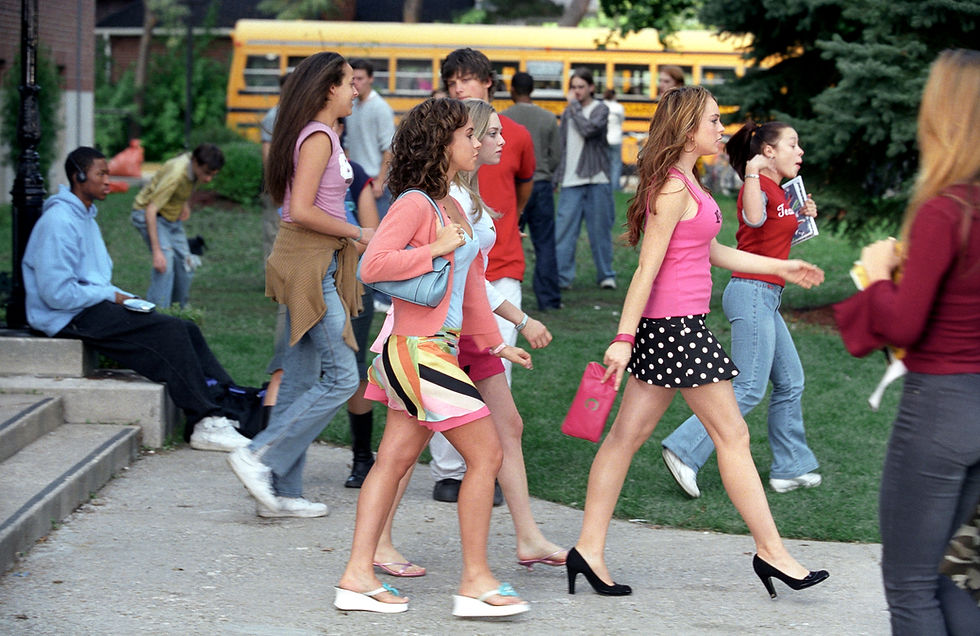The Cultural Analysis of A Modern Classic: Mean Girls
- Sukhmani Malhi

- Dec 13, 2019
- 3 min read
Updated: Mar 25, 2022

The modern cult classic, Mean Girls is a 2004 American teen comedy film which describes female high school social cliques and the damaging effects they can have on girls. It is based on a sociological book titled Queen Bees and Wannabes: Helping Your Daughter Survive Cliques, Boyfriends, and Other Realities of Adolescence by Rosalind Wiseman and was directed by Mark Waters, and written by Tina Fey. The protagonist is Cady Heron, who moves to Illinois with her family from Africa, where she was home schooled her whole life. Cady provides an etic view of the elaborate American high school social relations. Mean Girls can be viewed as a counter culture narrative which addresses issues of identity, culture and power dynamics. It gives a critique on the master narrative of social ideologies about young women in America. The outcasts, Janis Ian and Damien, who are the first ones to embrace Cady, along with other cliques who are not part of the infamous “Mean Girls” known as “The Plastics”, can be labelled as the counter culture, making the Plastics, led by Regina George, the master narrative. Here, Janis and Damien threaten the master narrative because of their gender and sexuality, through which the characters either align with or oppose the master narrative. At the end of the movie, Cady wins the title of Homecoming Queen but breaks her crown into pieces for everyone, as a way of eliminating social hierarchy and sends a message of how they should all be treated equally, regardless of their gender, sexuality or appearances. The dominant ideologies of patriarchy in America requires women to be passive objects, who concern themselves with superficial matters like their level of attractiveness, popularity or the clothes they wear. This film breaks away from that. The Mean Girls of the school who are perceived as “perfect” and “teen royalty” by everyone, are constantly preoccupied with their looks, body images and their position in the social hierarchy of the school. This deconstructs the image of the ideal woman, who herself can never be satisfied with herself. Through its ridiculous over exaggeration of stereotypes about women, the movie satirically and successfully critiques the hegemonic ideologies that exist in the American high school system, as a microcosm of the country as a whole. The film reflects the dominant narratives at certain instances in the form of caricatures. The prominent ones being those of the “dumb blonde girl” tropes and the continued foolish rivalry between women. The character development of Cady, evolves throughout the movie. She, a daughter of two zoologists who is interacting with kids of her age for the first time, starts with an anthropological perspective towards the social order within the school. She is inquisitive, analytical and questioning and loves math. It is her perceived attractiveness which serves as social currency, which makes her either a potential threat or a prospective addition to the Mean Girls clique. Cady tries to fit in but eventually tries to replace Regina. In order to get her crush, Aaron Samuels to like her, Cady also pretends to be bad at calculus so that he would tutor her. She also starts dressing more promiscuously, wearing more make-up and behaving like Regina. She later realises that she was trying to be someone she’s not, by being sucked into the petty power politics and mind games. Both girls try to manipulate each other in their fight for power. The socio-political climate of the school is one of segregation, ostracization and humiliation. The movie becomes a mirror for the hegemonic ideologies surrounding gender, power and identity. A cultural analysis of the power and social dynamics in Mean Girls presents how it views the workings of society through a microscope. As a cultural artefact, the movie demonstrates subcultures, ethnocentrism and multiculturalism. It displays the norms and sanctions within the social environment of an American public school. It uses symbols like the Burn Book which is used by Regina to write unpleasant rumours about others expose the deepest darkest secrets of the students. Mean Girls offered especially incisive commentary on the social pressures that teenage girls face, whether it’s Eurocentric beauty ideals, class divisions, heteronormativity or the idea that one’s value is tied into attracting and keeping a man. The Mean Girls’ status is visibly linked to class and wealth. Regina George was a forecast of today’s Instagram influencers who flaunt their mansions and cars. She herself deals with insecurities surrounding her body and the movie touches upon eating disorders among girls of that age who subject their bodies to heavy scrutiny to gain acceptance. Problematic norms which are addressed in the movie range from toxic beauty standards to slut-shaming. Almost every girl in the school tries to maintain herself as attractive and reputable at the same time. This is known as the Madonna-whore complex, where women are expected to compartmentalize their sexuality, desires, and personalities in ways that men are not expected to.







Comments